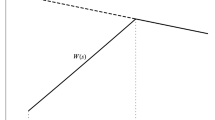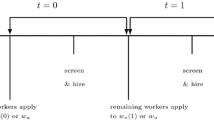Summary
We analyse the impact of wage envy on employment and on its sectorial allocation. A multi-sector general equilibrium model in which externalities among sectors arise through wage envy and decentralized bargaining is presented. In the no externality case, sectorial employment is a function of sectorial productivity and of the disutility of work. In the externality case, sectorial employment is additionally affected by union power in all sectors (with a negative sign even though bargaining is efficient), by the productivity in the other sectors (with an undetermined sign) and by the relative average propensity to consume goods of this sector (with a positive sign).
Similar content being viewed by others
References
Akerlof, G. (1969), ‘Relative Wages and the Rate of Inflation,’Quarterly Journal of Economics, 83, pp. 353–374.
Andersen, T. and M. Christensen (1989), ‘Relative Wages and Employment Fluctuations,’ Journal of Macroeconomics, 11, pp. 477–492.
Aukrust, O. (1977), ‘Inflation in the Open Economy: A Norwegian Model,’ in: L. Krause and W. Salant (eds.),Worldwide inflation, The Brookings Institution, Washington DC.
Cahuc, P. and A. Zylberberg (1991), ‘Niveaux de négociations salariales et performances macroéconomiques,’Annales d'Economie et Statistique, 23, pp. 1–12.
Cooper, R. and A. John (1988), ‘Coordinating Coordination Failures in Keynesian Models,’Quarterly Journal of Economics, 53, pp. 441–463.
Dixon, H. (1988), ‘Unions, Oligopoly and the Natural Range of Employment,’Economic Journal, 98, pp. 1127–1147.
de la Croix, D. (1993), ‘Wage Interdependence and Competitiveness,’Recherches Economiques de Louvain, 59, pp. 395–426.
Dunlop, J. (1944),Wage Determination Under Trade Unions, New York.
Gylfason, T. and A. Lindbeck (1984a), ‘Union Rivalry and Wages: An Oligopolistic Approach,’Economica, 51, pp. 129–139.
Gylfason, T. and A. Lindbeck (1984b), ‘Competing Wage Claims, Cost Inflation, and Capacity Utilization,’European Economic Review, 24, pp. 1–21.
Jacobs, J. and M. Janssen (1990), ‘Coordinating Unions, Wages and Employment,’De Economist, 138, pp. 321–339.
Jacobsen, H. and C. Schultz (1990), ‘A General Equilibrium Macro Model with Wage Bargaining,’Scandinavian Journal of Economics, 92, pp. 379–398.
Holmlund, B. (1989), ‘Wages and Employment in Unionized Economies: Theory and Evidence,’ in: B.L. Holmlund, K.-G. Lofgren and L. Engstrom,Trade Unions, Employment, and Unemployment Duration, Oxford.
Keynes, J.M. (1936),The General Theory of Employment, Interest and Money, London.
Layard R., S. Nickell and R. Jackman (1991),Unemployment—Macroeconomic Performance and the Labour Market, Oxford.
MacDonald, I. and R. Solow (1981), ‘Wage Bargaining and Employment,’American Economic Review, 71, pp. 898–908.
Mitchell, D.B.J. (1980),Unions, Wages, and Inflation, Brookings Institution, Washington DC.
Additional information
Rijksuniversiteit Limburg, FNRS and Université Catholique de Louvain. I would like to thank Franz Palm for valuable comments on an earlier draft. This paper benefitted also from discussions with Torben Andersen, Jacques Drèze and Henri Sneessens (without implying them in any mistake). The detailed comments of the anonymous referee contributed to a large extent to clarify the exposition of the model.
Rights and permissions
About this article
Cite this article
De la Croix, D. Employment response to supply and demand shocks under envy in wage formation. De Economist 142, 193–209 (1994). https://doi.org/10.1007/BF01388165
Issue Date:
DOI: https://doi.org/10.1007/BF01388165




